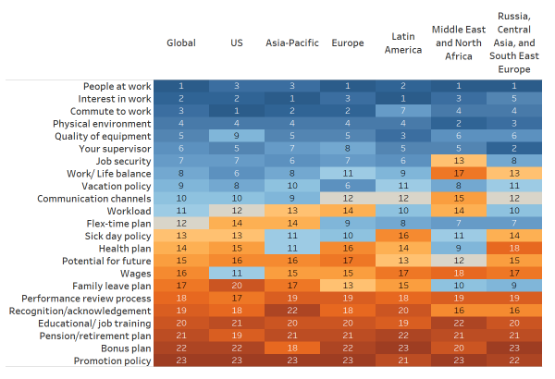Global Job Satisfaction: Worker satisfaction driven by universal job components
29 Aug. 2018 | Comments (0)
For the first time we are comparing job satisfaction globally. In the latest 2018 Q1 report of The Conference Board® Global Consumer Confidence Survey, a new global survey conducted in collaboration with Nielsen, workers in 64 countries were asked the same question: “To what extent are you satisfied with your current job?”
Interestingly, all around the world workers have similar reasons to wake up every day and go to work. On the other hand, there are also similar aspects of work that hamper workers’ satisfaction. Among the 23 components of job satisfaction, there appears to be a universal ranking of components of job satisfaction. In Europe, the US, Asia-Pacific, Latin America, and the Middle East, workers generally agree on what brings them the most and least satisfaction. Chart 1 summarizes the results.
Globally, people at work are the main reason why people enjoy their workday. The interest in work ranks second and is followed by the commute to work, the physical environment, and the quality of the equipment. In Europe, this top 5 list is identical and the results are almost the same for the other regions except that employees get relatively more satisfaction from the interaction with their supervisor. There also appear to be some differences. For example, comparing Europe to the US, European workers are generally more satisfied with their vacation and sick day policy as well as their flexibility at work and family leave plan than Americans. On the other hand, while US workers are less satisfied with these secondary work benefits, they are clearly more satisfied with their wages.
Chart 1: Worker satisfaction seems to be driven by universal job components.

Note 1: The survey sample includes internet users who agreed to participate and has quotas based on age and gender for each country. Results are weighted to be representative of internet consumers by country. Rankings were calculated within each region. A rank of “1” highlights the highest level of satisfaction.
Note 2: Europe includes Austria, Belgium, Bulgaria, Croatia, Czech Republic, Denmark, Estonia, Finland, France, Germany, Greece, Hungary, Ireland, Italy, Latvia, Lithuania, the Netherlands, Norway, Poland, Romania, Slovakia, Slovenia, Spain, Sweden, Switzerland, and the UK. Asia-Pacific includes Australia, Hong Kong, Indonesia, Japan, Malaysia, New Zealand, Philippines, Singapore, South Korea, Taiwan, and Vietnam. Latin America includes Argentina, Brazil, Chile, Colombia, Costa Rica, Mexico, Peru, and Venezuela. Middle East and North Africa includes Belarus, Egypt, Israel, Morocco, Saudi Arabia, and the United Arab Emirates. Russia Central Asia and South East Europe includes Kazakhstan, Russia, Serbia, Turkey, and Ukraine.
Note 3: For each country, 500 internet-based responses were collected. Only employed people answered the job satisfaction questions.
Source: The Conference Board® Global Consumer Confidence Survey 2018 Q1 https://www.conference-board.org/data/bcicountry.cfm?cid=15
While workers around the world find similar components of work to be most satisfying, the same trend appears for components of work they find least satisfying. Globally, workers are least satisfied with the promotion policies of their company. Education and job training also ranked low universally. While workers enjoy what they do, many perceive there is too little support to broaden their capabilities and no opportunity for their next challenge. Moreover, bonuses and retirement plans are generally viewed as unsatisfactory, as are wages. While companies may be hesitant to increase monetary compensation in the form of wages or secondary benefits, many workers are as well unsatisfied with their non-financial recognition- and acknowledgement. Employers could aspire to improve their employee relations and provide more opportunities for development and recognition.
With the labor market tightening in advanced countries, employers may be more willing to offer better benefits to attract or retain talent. At the same time, employees or unions could assert more pressure and demand better working conditions, like wages and benefits, knowing that job security is more assured in times of strong economic growth and tight labor markets. The combination of these two forces could result in greater satisfaction among workers. For employers this could result in higher labor costs, though on the other hand, it opens the opportunity to invest in the development of their human capital.
-
About the Author:Frank Steemers
The following is a bio or a former employee/consultant Frank Steemers is a Senior Economist at The Conference Board where he analyzes labor markets in the US and other mature economies. Based in New …




0 Comment Comment Policy